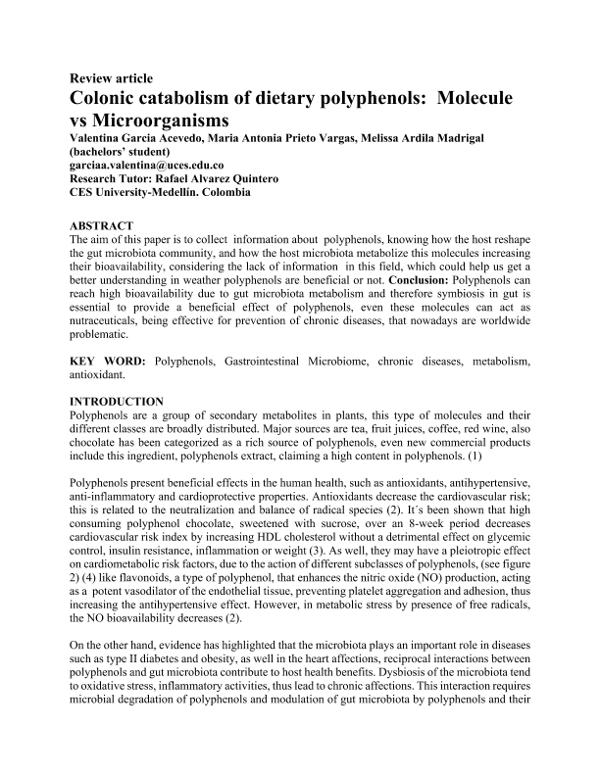Mostrar el registro sencillo del ítem
Colonic catabolism of dietary polyphenols: Molecule vs Microorganisms
| dc.contributor | Álvarez, Rafael | |
| dc.contributor.author | Ardila Madrigal, Melissa | |
| dc.contributor.author | Prieto Vargas, María | |
| dc.contributor.author | García Acevedo, Valentina | |
| dc.date.accessioned | 2020-11-19T16:26:12Z | |
| dc.date.available | 2020-11-19T16:26:12Z | |
| dc.date.issued | 2020-08-18 | |
| dc.identifier.uri | http://hdl.handle.net/10946/4985 | |
| dc.description.abstract | The aim of this paper is to collect information about polyphenols, knowing how the host reshape the gut microbiota community, and how the host microbiota metabolize this molecules increasing their bioavailability, considering the lack of information in this field, which could help us get a better understanding in weather polyphenols are beneficial or not. Conclusion: Polyphenols can reach high bioavailability due to gut microbiota metabolism and therefore symbiosis in gut is essential to provide a beneficial effect of polyphenols, even these molecules can act as nutraceuticals, being effective for prevention of chronic diseases, that nowadays are worldwide problematic. Polyphenols are a group of secondary metabolites in plants, this type of molecules and their different classes are broadly distributed. Major sources are tea, fruit juices, coffee, red wine, also chocolate has been categorized as a rich source of polyphenols, even new commercial products include this ingredient, polyphenols extract, claiming a high content in polyphenols. (1) Polyphenols present beneficial effects in the human health, such as antioxidants, antihypertensive, anti-inflammatory and cardioprotective properties. Antioxidants decrease the cardiovascular risk; this is related to the neutralization and balance of radical species (2). It´s been shown that high consuming polyphenol chocolate, sweetened with sucrose, over an 8-week period decreases cardiovascular risk index by increasing HDL cholesterol without a detrimental effect on glycemic control, insulin resistance, inflammation or weight (3). As well, they may have a pleiotropic effect on cardiometabolic risk factors, due to the action of different subclasses of polyphenols, (see figure 2) (4) like flavonoids, a type of polyphenol, that enhances the nitric oxide (NO) production, acting as a potent vasodilator of the endothelial tissue, preventing platelet aggregation and adhesion, thus increasing the antihypertensive effect. However, in metabolic stress by presence of free radicals, the NO bioavailability decreases (2). On the other hand, evidence has highlighted that the microbiota plays an important role in diseases such as type II diabetes and obesity, as well in the heart affections, reciprocal interactions between polyphenols and gut microbiota contribute to host health benefits. Dysbiosis of the microbiota tend to oxidative stress, inflammatory activities, thus lead to chronic affections. This interaction requires microbial degradation of polyphenols and modulation of gut microbiota by polyphenols and their metabolites, which inhibits pathogenic bacteria and stimulates beneficial bacteria, symbiosis | spa |
| dc.language.iso | en | spa |
| dc.subject | Polyphenols, Gastrointestinal Microbiome, chronic diseases, metabolism, antioxidant. | spa |
| dc.title | Colonic catabolism of dietary polyphenols: Molecule vs Microorganisms | spa |
| dc.type | Trabajo de Grado | spa |
| dc.rights.license | Abierto (texto completo) | spa |
Ficheros en el ítem
Este ítem aparece en la(s) siguiente(s) colección(ones)
-
Química Farmacéutica [77]


